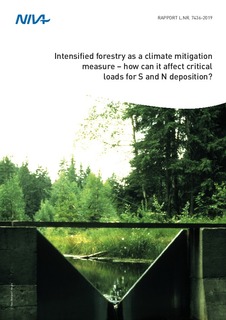| dc.contributor.author | Kaste, Øyvind | |
| dc.contributor.author | Wright, Richard Frederic | |
| dc.contributor.author | Valinia, Salar | |
| dc.date.accessioned | 2020-02-21T13:07:09Z | |
| dc.date.available | 2020-02-21T13:07:09Z | |
| dc.date.created | 2020-02-18T12:27:59Z | |
| dc.date.issued | 2019 | |
| dc.identifier.isbn | 978-82-577-7171-3 | |
| dc.identifier.issn | 1894-7948 | |
| dc.identifier.uri | http://hdl.handle.net/11250/2643251 | |
| dc.description | Project manager Øyvind Kaste | nb_NO |
| dc.description.abstract | More intensive forestry has been proposed in Norway as a climate mitigation measure. Growing forests capture CO2 from the atmosphere and the harvested biomass can comprise a carbon sink. Changes in forestry practices, however, might adversely affect the sensitivity of surface waters to acidification in poorly buffered ecosystems. Increased removal of biomass can accelerate the depletion of base cations from the soil. We calculated the effect of increased harvest intensity on the critical load of acidity to surface waters at two forested sites in Norway, Birkenes in Vest-Agder, and Langtjern in Buskerud. Model simulations of water quality, given several scenarios of future forest harvest, were carried out by applying the dynamic biogeochemical model MAGIC. Calculations of critical loads were based on the SSWC and FAB steady-state models. The results indicate that change from stem-only to whole-tree harvest will decrease the critical load of acidity, i.e. the ecosystem can tolerate less sulphur deposition. The critical load of nitrogen, on the other hand, will increase because more nitrogen is removed from the catchment. With whole-tree harvest, the catchments can tolerate more N deposition than with traditional stem-only harvest before significant leaching of NO3 and re-acidification occurs. Increased harvest intensity thus entails a trade-off: surface waters in sensitive areas will tolerate less sulphur deposition but more nitrogen deposition. | nb_NO |
| dc.description.sponsorship | Miljødirektoratet | nb_NO |
| dc.language.iso | eng | nb_NO |
| dc.publisher | Norsk institutt for vannforskning | nb_NO |
| dc.relation.ispartof | NIVA-rapport | |
| dc.relation.ispartofseries | NIVA-rapport;7436 | |
| dc.relation.ispartofseries | Miljødirektoratet-rapport;1563 | |
| dc.subject | Modellering | nb_NO |
| dc.subject | Modelling | nb_NO |
| dc.subject | Skogbruk | nb_NO |
| dc.subject | Forestry | nb_NO |
| dc.subject | Vannkvalitet | nb_NO |
| dc.subject | Water quality | nb_NO |
| dc.subject | Tålegrenser | nb_NO |
| dc.subject | Critical loads | nb_NO |
| dc.title | Intensified forestry as a climate mitigation measure – how can it affect critical loads for S and N deposition? | nb_NO |
| dc.title.alternative | Intensivert skogbruk som klimatiltak – hvordan kan det påvirke tålegrenser for S og N deposisjon? | nb_NO |
| dc.type | Research report | nb_NO |
| dc.description.version | publishedVersion | nb_NO |
| dc.rights.holder | © Norsk institutt for vannforskning/Norwegian Institute for Water Research & Norwegian Environment Agency The publication can be cited freely if the source is stated. | nb_NO |
| dc.subject.nsi | VDP::Matematikk og naturvitenskap: 400 | nb_NO |
| dc.subject.nsi | VDP::Mathematics and natural scienses: 400 | nb_NO |
| dc.source.pagenumber | 24 | nb_NO |
| dc.source.issue | 7436 | nb_NO |
| dc.identifier.cristin | 1795244 | |
| cristin.unitcode | 7464,30,23,0 | |
| cristin.unitname | Nedbørfeltprosesser | |
| cristin.ispublished | true | |
| cristin.fulltext | original | |
